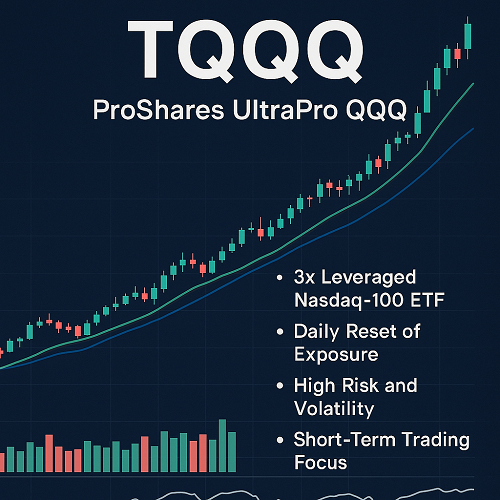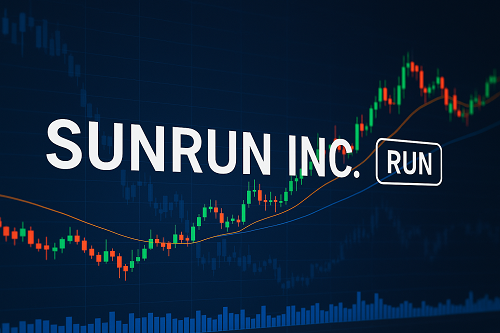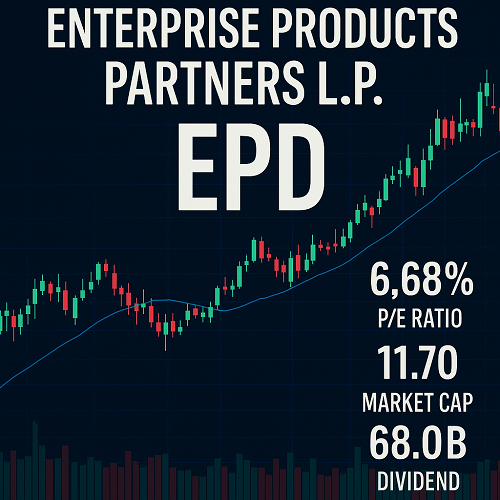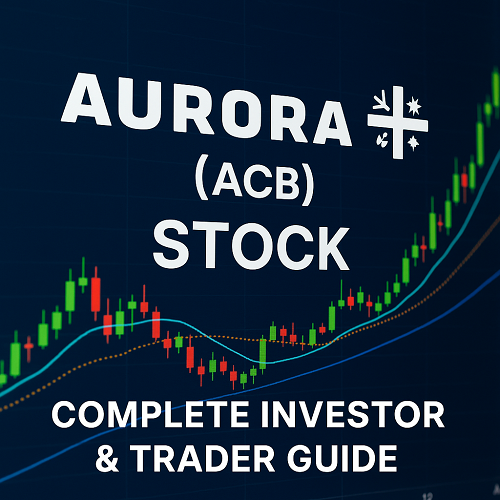What is TQQQ?
The ETF TQQQ — short for ProShares UltraPro QQQ — is a leveraged exchange-traded fund (ETF) offered by ProShares that seeks to deliver three times (3×) the daily performance of the QQQ (Invesco QQQ) Index, which tracks the NASDAQ‑100 Index. If you’re considering an investment in NASDAQ TQQQ, understanding its mechanics is crucial.
- Inception date: February 9, 2010.
- Underlying benchmark: Nasdaq-100 Index (non-financial largest companies listed on Nasdaq)
- Expense ratio: Net approx. 0.84% (as of fact sheet) but with fee-waiver arrangements.
- Key feature: 3× daily leveraged exposure. That means if the Nasdaq-100 rises 1% in a day (before fees/expenses), TQQQ aims to rise ~3%. If the index falls 1%, TQQQ could fall ~3%. Importantly, this is on a daily basis.
Because of this design, TQQQ is not a straightforward long-term holding for most investors—it’s a high-leverage instrument best understood in full before using.
How Does TQQQ Work? (Mechanics & Structure)
Daily Reset & Leverage Compounding
TQQQ resets its exposure daily to maintain ~300% of the benchmark’s daily return target. This “daily reset” mechanism means the fund is optimized for one-day moves, not necessarily long-term compounding.
- Example: If the Nasdaq-100 goes +2% in a day, TQQQ might go about +6%.
- But if over two days the index goes +2% one day and −2% the next, the cumulative return of TQQQ may differ from +6% then −6%; compounding effects and volatility drag can cause results to diverge.
Use of Derivatives, Swaps, Futures
TQQQ uses instruments such as swaps, futures contracts, and other derivatives to amplify exposure.
These instruments create additional layers of risk (counterparty, roll cost, tracking error) and make it more complex than standard index-tracking ETFs.
Holdings & Sector Exposure
Though TQQQ tracks the Nasdaq-100 index via derivatives, the underlying exposure replicates that index’s tech-heavy tilt. For example, top holdings (via underlying index) include companies like:
- NVIDIA, Microsoft, Apple, Amazon, Broadcom, Meta, Netflix, Tesla, Alphabet.
Sector weights: ~50-60% Information Technology, followed by Communication Services, Consumer Discretionary.
Risk and Return Characteristics
According to the fact sheet:
“While the Fund has a daily investment objective, you may hold Fund shares for longer than one day if you believe it is consistent with your goals and risk tolerance. For any holding period other than a day, your return may be higher or lower than the Daily Target. These differences may be significant.”
This means: extended holding periods increase tracking risk and volatility risk.
Why Investors Trade TQQQ: Potential Benefits
Here are the key reasons an investor or trader might use TQQQ:
a) Amplified Returns in an Up-Trend
In a strong bull market for large-cap technology stocks (as the Nasdaq-100 often represents), TQQQ offers the potential for three-times the upside of that index on a daily basis. If you have high conviction that tech is going to surge, TQQQ can magnify that bet.
E.g., in years where the Nasdaq-100 has had strong upward momentum, TQQQ returns can be very attractive.
b) Efficient Use of Capital
Instead of buying many individual technology stocks, TQQQ gives one trade to gain broad tech exposure with leverage. Even a smaller capital base can access large market moves via a single ticker.
c) Highly Liquid & Tradeable
TQQQ has significant assets under management (AUM) and is widely traded, which means good liquidity for entries and exits.
d) Tactical / Short-Term Strategy Tool
For traders, TQQQ can be used as a tactical instrument when anticipating short-term large upward moves (or when paired with hedging strategies). Because of its leverage, it can magnify short-term trades.
Why Many Investors Should Be Cautious: Risks & Considerations
While the upside potential is large, the risks are equally serious. Here are the main risk vectors to understand:
a) Volatility & Magnified Losses
Because TQQQ is 3× daily leverage, the same mechanism that boosts gains also boosts losses. A −1% day in the Nasdaq-100 can mean roughly −3% in TQQQ (before fees/derivative costs). In more volatile markets, losses can compound quickly.
b) Volatility Drag & Compounding Effects
If markets are choppy (up one day, down the next), TQQQ’s returns over time may deviate significantly from 3× the benchmark due to path dependency and compounding. This means that over longer periods, performance may under- or out-perform the simple 3× multiple depending on volatility regime.
c) Not Designed for Long-Term Buy & Hold (for Most)
Because of the above factors, most issuers and commentators caution that TQQQ is not ideal for long-term passive holding by typical investors. It’s better used with short-term horizon and active monitoring.
d) Derivative and Counterparty Risk
The use of swaps and futures implies additional layers of risk outside just the underlying equity market. There is counterparty exposure, financing costs, roll costs, etc. These all eat into performance especially during stress.
e) Expense Ratio & Fee Waiver Expiry
While the net expense ratio is relatively modest given the leverage (≈0.84%), investors need to understand that fee waivers may expire. Also, leveraged funds often have greater implicit costs (borrowing, derivatives) than plain-vanilla funds.
f) Suitability & Risk Tolerance
Because the fund can move violently, it requires high risk tolerance, active management, and clear exit strategy. It’s not a “set-and-forget” investment in the same way a broad index ETF is.
TQQQ vs. QQQ: Key Comparisons
A useful comparison for many investors is between TQQQ and the standard non-leveraged ETF QQQ (Invesco QQQ) which tracks the same Nasdaq-100 index.
| Feature | QQQ (Unleveraged) | TQQQ (3× Leveraged) |
|---|---|---|
| Target Daily Return | ~1× the Nasdaq-100 | ~3× the Nasdaq-100 |
| Expense Ratio | Low (e.g., ~0.2–0.3%) | Higher (~0.84% + derivative costs) |
| Volatility | Moderate (relative to broad market) | Very high – triple magnitude of movements |
| Suitability | Long-term passive growth | Tactical, short-term, high-risk/high-reward |
| Long-term Performance Risk | Lower risk of path dependency | High risk of tracking error, compounding drag |
| Ideal User Profile | Investor seeking tech exposure with broad diversification | Trader comfortable with leveraged exposure and active management |
As one commentary puts it:
“QQQ is designed for investors seeking long-term exposure to large-cap growth and technology stocks, while TQQQ caters to sophisticated traders looking to capitalize on short-term market shifts.”
Thus, when deciding between them, you must ask: Am I prepared to actively monitor and manage this leveraged instrument, or do I want simpler exposure?
Historical Performance & Key Metrics
While past performance is not predictive of future results, examining historical data helps contextualize how TQQQ has behaved.
Historical Returns
- Since inception (Feb 9 2010) TQQQ has delivered very strong annualized returns in favorable conditions, but with significant drawdowns.
- According to the fact sheet: Over certain multi-year time frames the fund has delivered high returns compared with the index.
Key Metrics
- Expense ratio: Net approx. 0.84% (with waiver) – subject to change.
- For Q2 2025, NAV: ~53.62% annualized for a certain multi-year period (fact sheet) vs index ~26.41%.
- 30-day SEC yield: ~0.72% for the quarter ending June 30, 2025.
- Major holdings (of underlying index) show tech dominance and concentration risk.
Drawdowns & Risk Episodes
- In volatile markets or large corrections, TQQQ has experienced steep drawdowns (often magnified compared to the index). For example, during tech sell-offs, leveraged ETFs struggled due to daily compounding and volatility.
- Because of the daily reset nature, even if the underlying index recovers, a leveraged fund may lag or suffer additional losses due to compounding.
When Might TQQQ Make Sense? Use-Case Scenarios
TQQQ can be an effective tool in certain scenarios—if used properly, with discipline.
Scenario 1: Bull Market Acceleration in Tech
If you believe strongly that large-cap tech (Nasdaq-100) is about to enter a sustained upward leg with low volatility, then TQQQ may serve as a leveraged way to capture that up-move. Example: during major AI/tech upcycles or definable breakout phases.
Scenario 2: Short-Term Tactical Trade
Because of its 3× leverage and daily reset, TQQQ is well-suited for short-term trading—day trading, swing trading over a few days where you expect a strong move.
Scenario 3: Hedge/Overlay Strategy
Some sophisticated investors may use TQQQ in conjunction with other ETFs or derivatives for hedging or overlay strategies—e.g., pairing with protective puts or inverse instruments when expecting a short term bounce.
Best Practices for Use
- Define a holding horizon: TQQQ works best when your horizon is short (days to a few weeks), especially if you expect a directional move.
- Monitor actively: Because of magnitude of moves, you need exit criteria in place.
- Control position size: Because of risk, you may allocate only a small percentage of your portfolio.
- Use stop-losses or protective strategies: Leverage means losses mount quickly.
- Consider market regime: Leveraged funds perform better in trending, low volatility markets. In choppy, sideways or declining markets they can underperform or lose big.
Typical Mistakes & Pitfalls to Avoid
Here are problems many investors face when using TQQQ without proper understanding:
- Holding for long periods expecting 3× of long-term index return – fails to account for compounding/volatility drag.
- Assuming the 3× will hold in all market conditions – it only targets daily returns, not multi-day or multi-year.
- Over-allocating capital given the risks – because of leverage, large losses can occur.
- Ignoring market regime: Leveraged funds suffer in sideways/choppy markets.
- Forgetting fees, derivative costs, and tracking error – these can reduce net return.
- Using it as a substitute for diversified long-term investing – may lead to unintended high risk exposure.
How to Evaluate TQQQ Before Trading / Investing
When considering TQQQ, here is a checklist:
- Time Horizon: How long do you plan to hold? Days? Weeks? Months?
- Conviction: Do you believe in a strong directional move in the Nasdaq-100 or large-cap tech?
- Risk Tolerance: Are you comfortable with 3× exposure and potential large drawdowns?
- Market Regime: Is the market trending upward with low volatility, or is it range-bound/volatile?
- Position Sizing: What fraction of your capital will you allocate? Do you have stop-loss or exit strategy?
- Costs: Consider expense ratio, derivative costs, brokerage costs, tax implications.
- Alternative Options: Would a non-leveraged ETF like QQQ or other tech-focused fund be more suitable?
- Liquidity & Execution: Ensure you can enter/exit effectively especially in volatile markets.
Example Strategy for Traders
Here’s a hypothetical swing-trade strategy using TQQQ:
- Setup: Nasdaq-100 shows breakout above key resistance, strong momentum, low implied volatility in options.
- Entry: Buy TQQQ at breakout with predefined stop-loss (say 10% below entry).
- Time horizon: 1-4 weeks, expecting tech rally.
- Position size: Limit to, for example, 5-10% of portfolio risk capital.
- Exit: Target a 20-30% gain (would equate to ~6-10% on the index if 3× holds). Or exit if momentum fades, or market volatility rises.
- Risk management: If stop-loss triggers, exit immediately. Monitor derivative cost/roll and ensure you track fund performance vs expectation.
Such a disciplined approach helps manage the leverage risk inherent in TQQQ.
FAQ – Common Questions & Answers
Q1: Can I hold TQQQ for years like a regular ETF?
A: You can hold it, but you should understand the risks: due to the daily reset mechanism and compounding effects, returns over long periods may differ significantly from 3× the benchmark. Many analysts caution against a “buy-and-forget” approach.
Q2: What happens during a market crash?
A: In a sharp downturn, TQQQ suffers magnified losses. Even if the index later recovers, the leveraged investor may need the index to rise by a much larger percentage to break even. Compounding and volatility hurt recovery.
Q3: Why does TQQQ sometimes underperform 3× the index over a month or year?
A: Because the 3× target is daily, and multi-day compounding plus volatility drag reduce effectiveness over timeframe longer than a day. Sideways markets and up-and-down moves hurt.
Q4: What are the fees and costs I should watch?
A: Besides the stated expense ratio (~0.84%), you should consider derivative/swaps cost, roll costs (for futures), bid-ask spread, and trading commissions. Also watch the fee waiver status.
Q5: Is TQQQ suitable for hedging?
A: It’s more oriented to leveraging upside than hedging downside. If you want bearish exposure you might consider inverse leveraged ETFs instead. For hedging, ensure you understand how the instrument behaves.
Final Thoughts – Is TQQQ Right for You?
TQQQ is a powerful tool in the right hands—when used with discipline, a clear strategy, and an understanding of its risks and mechanics. For traders anticipating a strong tech-led rally, it can deliver magnified upside. However, for typical long-term buy-and-hold investors, the risks and complexities may outweigh the benefits.
If you decide to use it:
- Treat it as a high-risk/high-reward instrument.
- Set clear entry and exit rules.
- Limit exposure relative to your overall portfolio.
- Be vigilant about market regime changes, volatility, and fund mechanics.
In short: TQQQ can amplify your bet on large-cap U.S. tech—but if you’re not prepared for rapid moves (up and down), it may be wiser to use a simpler, less leveraged alternative.





 XAUT-USD
XAUT-USD  AMD
AMD  MARA
MARA  SHOP
SHOP  BULL
BULL  CL=F
CL=F